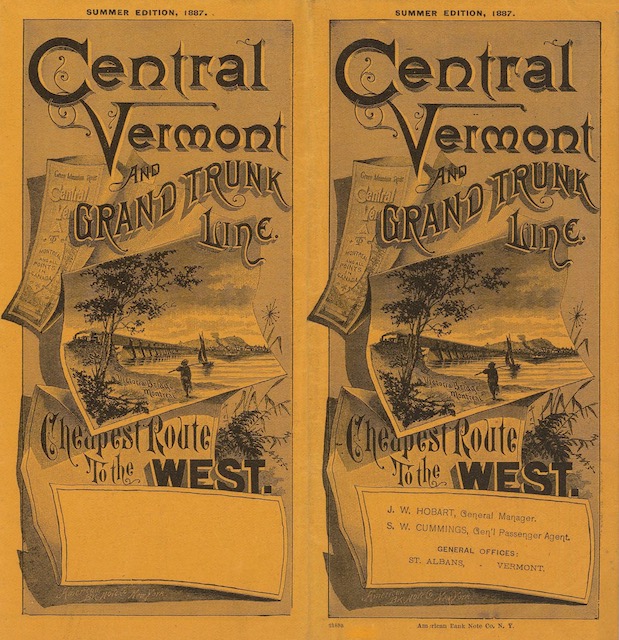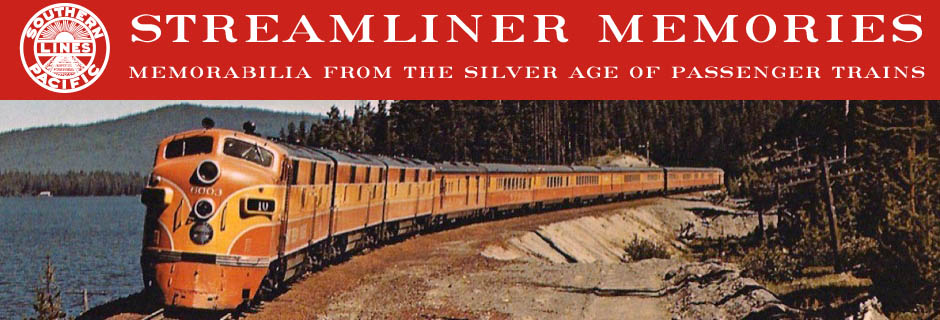The map on the back of this brochure has the heaviest lines going from Boston and New York in the East to Detroit and Chicago in the West. But Central Vermont only owned a tiny portion of this route, with the rest owned by the Grand Trunk and a variety of tiny New England railroads. While the bright orange cover of this brochure says “Central Vermont and Grand Trunk Line,” the rest of the brochure makes it clear that it was issued by Central Vermont, not Grand Trunk.
 Click image to download a 9.9-MB PDF of this timetable, which is from the David Rumsey map collection.
Click image to download a 9.9-MB PDF of this timetable, which is from the David Rumsey map collection.
In 1887, Central Vermont basically consisted of a line from St. Johns, Quebec south to Essex Junction, Vermont, where it split into a line to Bellows Falls and one to White River Junction, Vermont. There was also a branch from St. Johns to Sherbrooke, Quebec and one from St. Albans to Richford, Vermont, but there are no timetables for these lines.
Instead, this timetable is aimed at people going west (it includes no eastbound schedules), with the come-on, “Cheapest route to the West.” Five of the 16 panels on the non-map side present timetables with various routes from Boston to Chicago, St. Louis, and other cities in “the West.” All of these routes first require traveling on two other railroads to get to Bellows Falls or three railroads to get to White River Junction.
Two of the routes then go to St. Johns where they meet Grand Trunk trains. Two others go to Rouse’s Point where, after three changes of railroads, they go over the Lake Shore and other New York Central affiliates to Chicago and St. Louis. The final route goes via Bellows Falls to Rutland where it take the Delaware and Hudson to Utica, the New York Central to Buffalo, and NYC affiliates west.
While some of these routes offered through sleepers from Boston to Chicago, they weren’t fast. The 1885 New York Central timetable showed three trains from Boston to Chicago, one taking 31-1/2 hours and the other two 36 to 38 hours. The fastest route via Central Vermont was 44 hours and all but this route required more than 48 hours.
The brochure’s arguments for taking one of the CV routes were hollow. “The track” over the CV route “is laid with steel rails,” brags the brochure, as if the New York Central was using wooden ones. “The Dining-Stations are excelled,” but at least some New York Central trains had dining cars. “The cars are elegantly upholstered,” which I am sure was true on the New York Central.
Despite its time disadvantage, CV was confident enough that people would want to take one of these routes to Chicago that it included a map of downtown Chicago showing all of the railroad stations.
The CV’s fare from Boston to Chicago was $19 first class (about $620 in today’s dollars) plus at least $5.50 ($160 today) for sleeping accommodations or $17 ($550) second class. Unfortunately, the New York Central timetable didn’t list fares, so we’ll have to take the brochure’s word that it was the cheapest.
At the time this brochure was issued, Central Vermont and Grand Trunk were just connecting lines. But Central Vermont went bankrupt in 1896, Grand Trunk bought it and later it became part of the Canadian National system.
